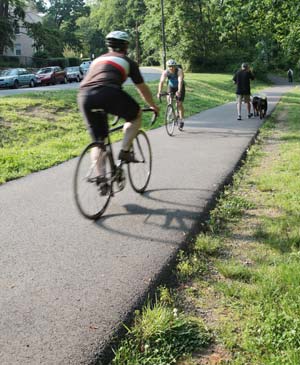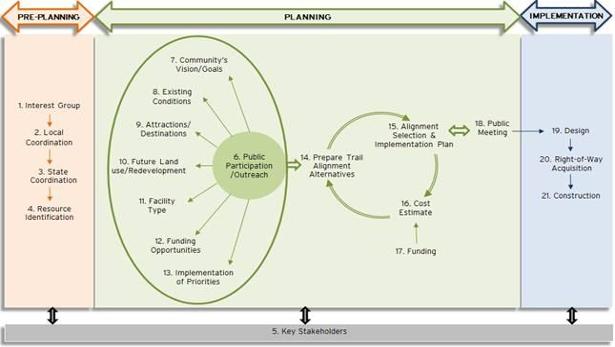Biking and Walking in Virginia
Community Trail Development Guide
Trail planning as a community effort is becoming more prevalent in Virginia as communities recognize the social, economic, environmental, transportation, and health benefits of incorporating trails.
Multi-use trails connect communities as well as enhance residents’ lives.
 Trail planning has traditionally been approached with a “top down” process, in which regional and state planners identify the need for a trail, design it in association with the local planners, and involve the public at key milestones of the project.
Trail planning has traditionally been approached with a “top down” process, in which regional and state planners identify the need for a trail, design it in association with the local planners, and involve the public at key milestones of the project.
In recent years, the importance of involving local residents in trail planning and the critical role it plays in the success of a trail’s recreational and transportation value has been recognized.
Trail planning and implementation requires a broad base of support, and no individual or group can do the job alone.
Unlike previous efforts, the Middleburg trail planning project heavily involved the local representatives at every stage of the planning process.
This project was undertaken to better understand the local trail planning process, and serve as a case study for the Trail Planning Guidebook.
Groups or individuals that should be involved in the planning process include:
- Property owners and renters
- Facility users
- Environmental interest groups
- Business organizations
- Historic preservation and scenic conservation groups
- Transportation interest groups
- Growth management groups
- Land developers
The need for a trail might arise from a common goal of the community to have more trails or to address a particular problem or concern in the community.
Concerns that lead to trail planning may include, but are not limited to, lack of safe paths for kids to walk or bike to school, lack of alternative modes of transportation to commute, and improve walking within a community.
As a part of the guide, community trail planning process was developed which shows public involvement in all phases of the planning and pre-planning process.
 This guide focuses on how to:
This guide focuses on how to:
- Create support throughout the community
- Empower local communities earlier in the planning process
- Identify funding options including public-private partnerships
- Balance, state, local jurisdiction, and community perspectives
- Encourage a planning process involving stakeholders, advocates, and community representatives
- Identify various options for trails
The guide was developed based on research of national best practices, the lessons learned from the Middleburg community trail planning pilot and knowledge of planning experts.
Community Trail Development Guide (PDF)
Most of the roads are constructed in the 60s and 70s when the benefits of multi-modal transportation network were not understood.
As a result, communities need to act with initiative and bring their proposals for pedestrian and bike facilities to the local and state transportation agencies.
When community involvement is combined with experts in the field, communities will add assets to their non-motorized transportation network and recreational facilities.



